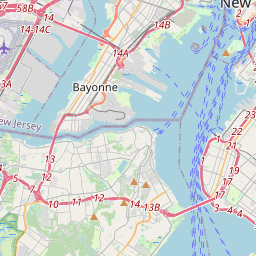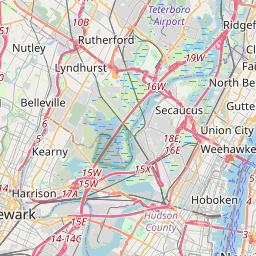Inscription
This sandstone fort was built in 1811 as one of five forts erected to defend New York Harbor. The fort originally stood on a small island that was linked to Manhattan by a 200-foot wooden causeway and drawbridge. In the 1850s, landfill extended Battery Park to this point.
The D-shaped fort held 28 cannons, but never saw military action. In 1823 the U.S. Army gave Castle Clinton to New York City, which used the structure in many ways over the next century.
After is designation as a National Monument in 1946, Castle Clinton was restored to its original appearance as a stone fort, and now serves as a National Park Service visitor center.
Text with upper drawing: New York Harbor (below) at the visit of Revolutionary War hero Marquis de Lafayette in 1824 - the year Castle Clinton, the fort, became Castle Garden, the amphitheater. first called the Southwest Battery, this fort was renamed Castle Clinton in 1815 for DeWitt Clinton (right), governor of New York.
History of Castle Clinton
1811 Soutwest Batter, renamed Castle Clinton in 1815, one of five forts to defend New York Harbor.
1824 Castle Garden (below), a fashionable amphitheater that was renovated into a concert hall in 1845.
1855 Emigrant Landing Depot (below), where eight million newcomers entered the United States between 1855 and 1890.
1896 New York City Aquarium (below), a diverse collection of fish viewed by the public until 1941.
1946 Castle Clinton National Monument, a unit of the National Park System.
The D-shaped fort held 28 cannons, but never saw military action. In 1823 the U.S. Army gave Castle Clinton to New York City, which used the structure in many ways over the next century.
After is designation as a National Monument in 1946, Castle Clinton was restored to its original appearance as a stone fort, and now serves as a National Park Service visitor center.
Text with upper drawing: New York Harbor (below) at the visit of Revolutionary War hero Marquis de Lafayette in 1824 - the year Castle Clinton, the fort, became Castle Garden, the amphitheater. first called the Southwest Battery, this fort was renamed Castle Clinton in 1815 for DeWitt Clinton (right), governor of New York.
History of Castle Clinton
1811 Soutwest Batter, renamed Castle Clinton in 1815, one of five forts to defend New York Harbor.
1824 Castle Garden (below), a fashionable amphitheater that was renovated into a concert hall in 1845.
1855 Emigrant Landing Depot (below), where eight million newcomers entered the United States between 1855 and 1890.
1896 New York City Aquarium (below), a diverse collection of fish viewed by the public until 1941.
1946 Castle Clinton National Monument, a unit of the National Park System.
Details
| HM Number | HM5JX |
|---|---|
| Tags | |
| Placed By | National Park Service |
| Marker Condition | No reports yet |
| Date Added | Wednesday, October 1st, 2014 at 12:24am PDT -07:00 |
Pictures
Locationbig map












| UTM (WGS84 Datum) | 18T E 583091 N 4506312 |
|---|---|
| Decimal Degrees | 40.70353333, -74.01641667 |
| Degrees and Decimal Minutes | N 40° 42.212', W 74° 0.985' |
| Degrees, Minutes and Seconds | 40° 42' 12.72" N, 74° 0' 59.10" W |
| Driving Directions | Google Maps |
| Area Code(s) | 212, 917, 646, 516, 347, |
| Closest Postal Address | At or near 2018 Battery Park Underpass, New York NY 10004, US |
| Alternative Maps | Google Maps, MapQuest, Bing Maps, Yahoo Maps, MSR Maps, OpenCycleMap, MyTopo Maps, OpenStreetMap |
Is this marker missing? Are the coordinates wrong? Do you have additional information that you would like to share with us? If so, check in.
Nearby Markersshow on map
Show me all markers in: New York, NY | New York County | 10004 | New York | United States of America
Maintenance Issues
- Is this marker part of a series?
- What historical period does the marker represent?
- What historical place does the marker represent?
- What type of marker is it?
- What class is the marker?
- What style is the marker?
- Does the marker have a number?
- What year was the marker erected?
- This marker needs at least one picture.
- Can this marker be seen from the road?
- Is the marker in the median?

Comments 0 comments